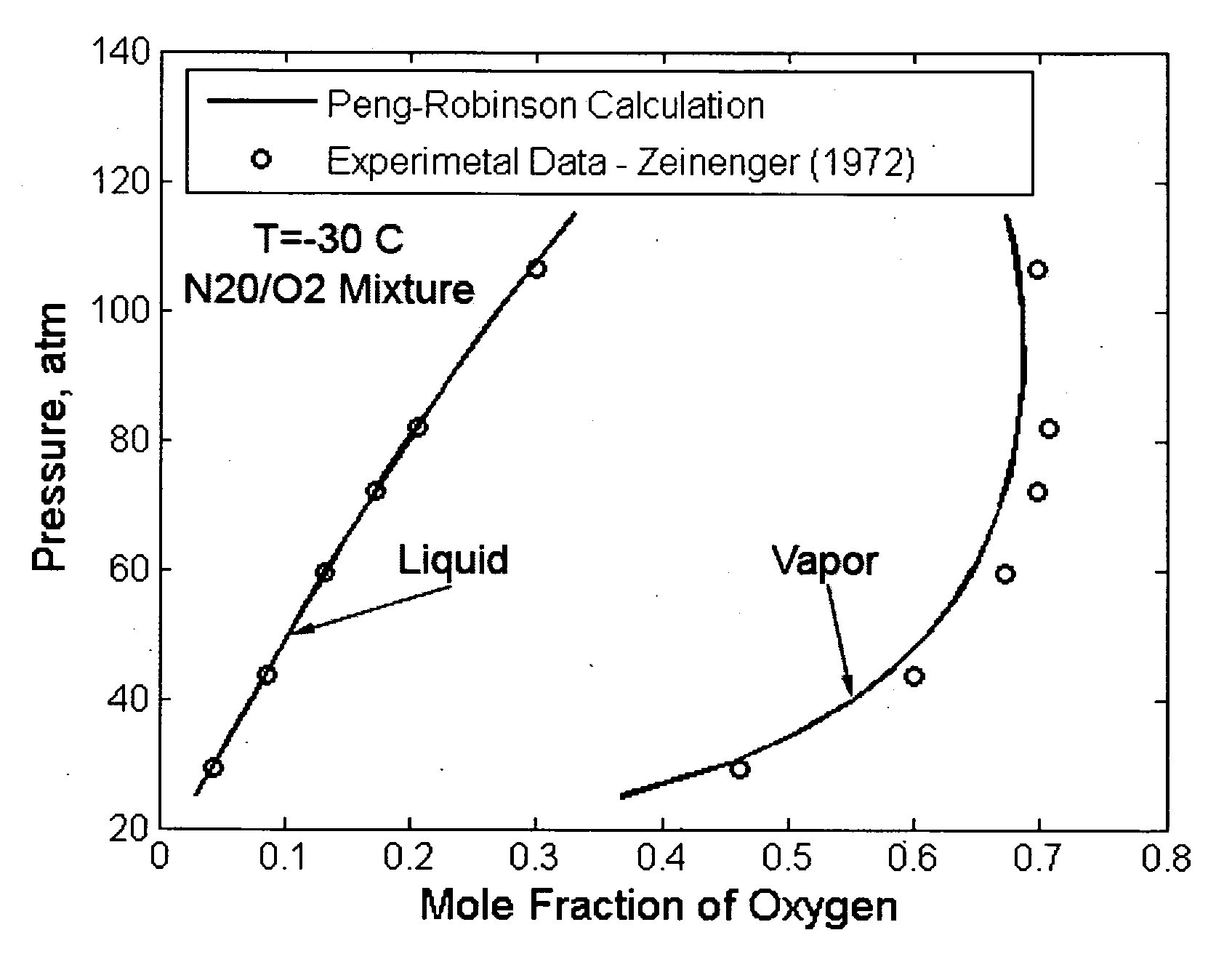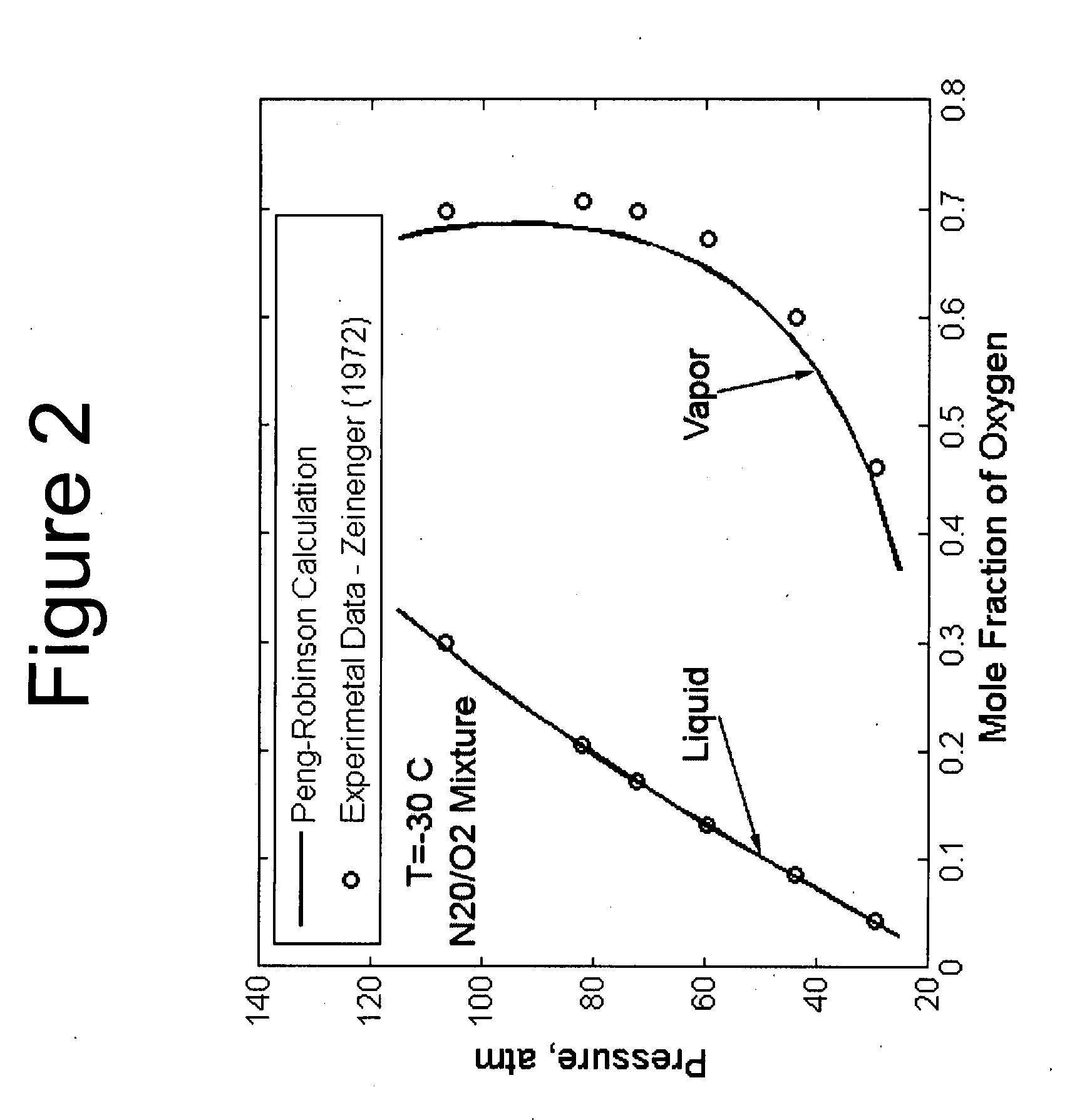Mixtures of oxides of nitrogen and oxygen as oxidizers for propulsion, gas generation and power generation applications
a technology of gas generation and power generation, applied in the direction of gaseous fuels, machines/engines, explosives, etc., can solve the problems of significant safety issues, low isp performance of solid rocket oxidizers, and limited list of potential oxidizers currently available for chemical propulsion and power generation systems, etc., to achieve low cost, improve density impulse, and operation simplicity
- Summary
- Abstract
- Description
- Claims
- Application Information
AI Technical Summary
Benefits of technology
Problems solved by technology
Method used
Image
Examples
example 1
[0101]Determination of the Properties of Pure Systems and Mixtures using the Peng-Robinson Equation of State.
[0102]As discussed by Peng and Robinson (“New Two Constant Equation of State”, 1976), the Peng-Robinson equation of state (EOS) which is given by Eq. 1 is widely used for pure systems and mixtures due to its simplicity and higher accuracy (especially at high pressures) compared to the other cubic EOS such as Soave-Redlich-Kwong equation.
P=RTv-b-a(T)v(v+b)+b(v-b),(1)
[0103]Here P, T, v are pressure, temperature and molar volume, respectively and R is the gas constant. Note that the attraction parameter, a, is a function of temperature and the van der Waals covolume, b, is constant. For most applications it is convenient to express Eq. 1 in the following cubic form.
Z3−(1−B)Z2+(A−3B2−2B)Z−(AB−B2−B3)=0 (2)
[0104]Here the coefficients A and B and the compressibility Z are defined as
A=aPR2T2,B=bPRTandZ=PvRT.(3)
[0105]Note that in the two phase region, the largest root of Eq. 2 corre...
example 2
Predicting the Properties of Equilibrium Mixtures:
[0115]It has been determined that a single parameter (k12) binary mixing rule used in conjunction with the Peng-Robinson equation of state results in predictions that are in reasonably good agreement with the experimental findings.
[0116]The following “mixture rule” which is recommended by Zudkevitch and Joffe (1976) is commonly used for predicting the properties of non-ideal solutions of fluids as applied to the above EOS.
a=∑i=1N∑j=1Nxixjaij(10a)b=∑i=1Nxibi(10b)aij=(1-kij)(aiaj)1 / 2(10c)
[0117]Here xi refers to the mole fraction of the ith component. The interaction coefficient, kij, accounts for the interaction between the molecules and it is typically experimentally determined. For an ideal solution, kij is zero and deviation from zero indicates strong molecular interaction. In general, the interaction parameter is a function of temperature and it typically takes a minimum value. This fact has been demonstrated in FIG. 2 for the N2O / ...
example 3
Determining Isp and Impulse Density for an Oxidizer of the Invention Based on the Density and Oxygen Mass Fraction.
[0121]It is instructive to use an example to illustrate the method of determining the critical performance parameters (such as Isp and impulse density) for various mixtures of oxygen / nitrous oxide oxidizers. These performance parameters are needed in the design calculations of an operational system. For the purposes of this example, we arbitrarily select an initial tank temperature and pressure of −40 C and 60 atm, respectively. Note that the density and oxygen concentration in the liquid phase are the two critical state variables that are needed to estimate the propulsion system parameters. In order to obtain these state variables, one can use a proven mixture rule and equation of state combination.
PUM
| Property | Measurement | Unit |
|---|---|---|
| mass fraction | aaaaa | aaaaa |
| temperature | aaaaa | aaaaa |
| temperature | aaaaa | aaaaa |
Abstract
Description
Claims
Application Information
 Login to View More
Login to View More - R&D
- Intellectual Property
- Life Sciences
- Materials
- Tech Scout
- Unparalleled Data Quality
- Higher Quality Content
- 60% Fewer Hallucinations
Browse by: Latest US Patents, China's latest patents, Technical Efficacy Thesaurus, Application Domain, Technology Topic, Popular Technical Reports.
© 2025 PatSnap. All rights reserved.Legal|Privacy policy|Modern Slavery Act Transparency Statement|Sitemap|About US| Contact US: help@patsnap.com



